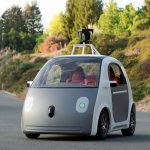Eye-tracking technology comes to General Motors
So you’ve had your eye on that hot little number from General Motors. Sometime between now and 2019 you can expect it to return your gaze.
Thank the company: the automaker recently inked a deal with Seeing Machines to purchase tracking devices for 500,000 vehicles over the next five years, says the Financial Times. The devices will display technology that tracks a motorist’s eyes and face as she drives, with some elements able to detect where and for how long a driver is looking.

One potential application for in-vehicle eyetracking: making sure truck drivers aren’t sleeping at the wheel. From Gamma Man.
While it’s unclear exactly which components of the technology GM is purchasing, those capabilities signal new possibilities for drivers and automakers. Because the technology can determine within one degree which way drivers are looking, you may soon be able to change a radio station simply by glancing at the dashboard knob. Or your car may speak up to let you know you’ve glanced one second too long at your smartphone.
Such features are already found in industries like trucking and mining, where they detect driver fatigue or distraction. Once such information is captured, the technology can suggest to drivers that they pull over to rest or safely finish texting.
GM follows the lead of other carmakers that have already incorporated technology seeking to lessen distractions and increase safety for motorists. Toyota’s Lexus, for example, uses a “Driver Attention Monitor” system with a motorist-facing camera that tracks a driver’s eyelids to determine if she’s looking away from the road or perhaps growing drowsy. And the new Volvo XC90 is semi-autonomous; its auto-braking capability prevents accidents in numerous scenarios.
GM’s deal with Seeing Machines heralds a significant advancement for the mass-market adoption of more self-aware cars. Says Karl Brauer, an analyst for Kelly Blue Book, “Carmakers know we’re heading for a world of autonomous vehicles that do much of the thinking for us.”
“In the race to get there,” he continues, “most of them are embracing advanced technology as soon as there’s a viable business case.”
Even as carmakers bet on more autonomous cars, they face concerns from the public about privacy. For instance, the National Highway Transportation Safety Administration is debating regulations that would require vehicles to communicate with another and share information such as speed and direction.
Under GM’s driver-tracking technology, privacy-sensitive motorists can choose to opt out of such systems for now, but in the future, cars that measure distraction and fatigue may become ubiquitous and drivers won’t be allowed to disable the technology—nor will they mind, so commonplace will it be.
For the moment, however, being able to disable the technology remains a selling point. Buyers who don’t like it are appeased, as are those who want bragging rights to the latest high tech features, says Brauer.
“The goal is to ease buyers into adopting the new technology,” he says, “with a full expectation that every car buyer will eventually understand and embrace it.”
Related Posts
Category: New Products, Parking Tech

















